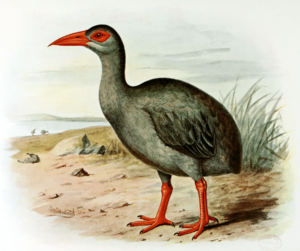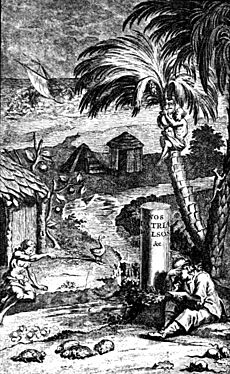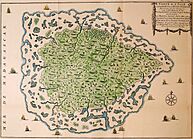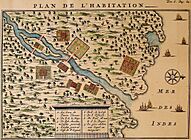Rodrigues rail facts for kids
Quick facts for kids Rodrigues rail |
|
|---|---|
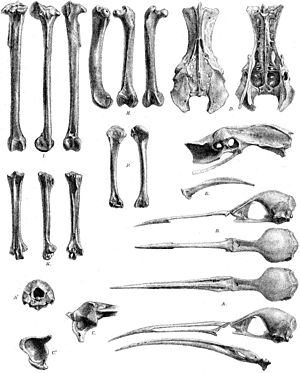 |
|
| Subfossil bones described in 1879, including two skulls, a pelvis, and limb bones | |
| Conservation status | |
| Scientific classification | |
| Genus: |
Erythromachus
|
| Species: |
leguati
|
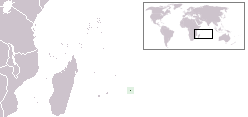 |
|
| Location of Rodrigues | |
| Synonyms | |
|
List
Aphanapteryx leguati Günther & Newton, 1879
Miserythrus leguati Newton, 1874 Erythromachus leguata Fürbringer, 1888 (lapsus) Aphanopteryx leguati Rothschild, 1907 (lapsus) Myserythrus leguati Hachisuka, 1953 (lapsus) Erthyromachus leguati Brodkorb, 1967 (lapsus) |
|
The Rodrigues rail (Erythromachus leguati) was a bird that lived only on the island of Rodrigues. This island is part of the Mascarene islands. The Rodrigues rail was a member of the rail family. Sadly, this bird is now extinct, meaning it no longer exists.
People first wrote about the Rodrigues rail between 1691 and 1726. Later, in 1874, scientists found subfossil bones of the bird. These bones matched the old descriptions. The species was then named E. leguati to honor one of the first people who wrote about it, François Leguat. The Rodrigues rail is usually placed in its own group, called Erythromachus. It is related to the red rail from Mauritius.
The Rodrigues rail was about 35 centimeters (14 inches) long. It weighed at least 500 grams (18 ounces). People described it as having grey feathers. It had a red beak, red legs, and a red, bare patch around its eye. Its beak was long and curved downwards. This bird could not fly. It ate the eggs of tortoises. Hunters noticed that the Rodrigues rail was attracted to red objects. They used this to catch the birds easily. The Rodrigues rail likely died out in the mid-18th century. This was mainly because of hunting and new animals like cats.
Contents
Discovering the Rodrigues Rail
In 1848, a scientist named Hugh Edwin Strickland learned about a bird. It was mentioned in a book by a French traveler, François Leguat. Leguat had lived on Rodrigues island from 1691 to 1693. He called the birds "gelinottes," which meant "wood-hens." Strickland thought this name was like the European grouse. But the bird's beak, as Leguat described it, was different. Strickland could not fully identify the bird. However, he saw some similarities to the dodo and kiwi. He also noticed it was similar to the red rail from Mauritius.
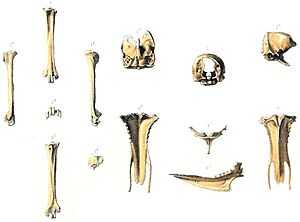
In 1874, a French scientist, Alphonse Milne-Edwards, studied some bird bones. These bones were subfossils found on Rodrigues. They had been dug up by Edward Newton's team. Milne-Edwards connected Leguat's story to these bones. He found three bones: a sternum (breastbone), a tarsometatarsus (lower leg bone), and a skull piece. These were found in caves on Rodrigues. He saw that they were similar to the red rail's bones. He named the bird Erythromachus leguati. The name Erythromachus comes from Greek words meaning "red" and "battle." This refers to the bird's attraction to red objects. The name leguati honors François Leguat.
In 1875, Alfred Newton found another old description of the bird. It was in a travel account from 1725–26 by Julien Tafforet. In 1879, more fossils were found, including skulls. Scientists Albert Günther and E. Newton confirmed the bird was a rail. They also noted that some beaks were curved like the red rail's. Today, scientists agree that Leguat's writings are true observations of these birds. His notes are some of the first detailed accounts of animal behavior in the wild.
How the Rodrigues Rail Evolved
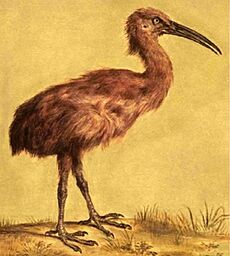
The Rodrigues rail was a close relative of the red rail. Both birds lived on islands and could not fly. Scientists think they came from the same bird group. Over time, they changed and became different species. The fact that the red rail had very few feathers shows it lived alone for a long time.
Rails often travel to new islands. When they arrive, they can quickly lose the ability to fly. This happens because there are no predators on the islands. But this also makes them very vulnerable to new dangers. The Rodrigues rail and red rail likely evolved their unique features over a long time. These features, like not being able to fly, helped them survive on their islands.
What the Rodrigues Rail Looked Like
The Rodrigues rail was about 35 centimeters (14 inches) long. It was smaller than the red rail. But it had longer wings for its size. It likely weighed at least 500 grams (18 ounces). The bones found show that the birds varied in size. This might mean males and females were different sizes.
The bird had bright grey feathers, possibly with white spots. Its beak and legs were red. It also had a red, bare patch around its eyes. Its skull was slightly long and rounded. The beak was long and curved downwards, like the red rail's. The nostrils were also very long. Some scientists noted that the beaks varied a lot in size and shape. Some were short and straight, while others were long and curved.
The bones in its front limbs (wings) were small. This is typical for a bird that cannot fly. Its shoulder blade was small and narrow. The breastbone was also small. The upper arm bone was very small and curved. The lower arm bones were short. However, its pelvis and leg bones were very strong. This helped it run well. The Rodrigues rail had a wider and shorter skull than the red rail. It also had longer nostrils and a different feather color.
Old Descriptions of the Bird
The Rodrigues rail was first written about by François Leguat in his 1708 book. He described the bird like this:
Our 'gelinotes' are fat all the year round and of a most delicate taste. Their colour is always of a bright grey, and there is very little difference in plumage between the two sexes. They hide their nests so well that we could not find them out, and consequently did not taste their eggs. They have a red naked area round their eyes, their beaks are straight and pointed, near two and two-fifths inches long, and red also. They cannot fly, their fat makes them too heavy for it. If you offer them anything red, they are so angry they will fly at you to catch it out of your hand, and in the heat of the combat we had an opportunity to take them with ease.
Julien Tafforet also described the bird in 1725–26:
There is another kind of bird, the size of a young hen, which has the beak and legs red. Its beak is roughly like that of a curlew, except that it is a little deeper and not quite so long. Its plumage is mottled with white and grey. They generally feed on the eggs of the land tortoises, which they take from the ground, and makes them so fat that they often have difficulty running. They are very good to eat, and their fat is of a yellowish-red, which is excellent for pains. They have small pinions [wings], without feathers, so they cannot fly; but on the contrary, they run very well. Their cry is a continual whistling. When they see somebody pursuing them they produce another sort of noise from their bodies, like that of a person who has hiccups and with the stomach tensed.
Unlike other extinct birds from the Mascarene islands, no drawings of the Rodrigues rail were made when it was alive. Later drawings by artists like Frederick William Frohawk were based on these old written descriptions.
Behaviour and Diet
According to Tafforet, the Rodrigues rail ate the eggs of the now extinct giant tortoises. Three types of these tortoises lived on Rodrigues. The rails would eat many eggs during the tortoise breeding season. Scientists think they also ate baby tortoises. At other times of the year, they probably ate snails and other small creatures. They might have also scavenged for food in seabird nesting areas.
Since Leguat could not find their nests, the Rodrigues rail might have nested in hidden places. They might have nested deep in the forests or mountains. Their nests were probably well hidden in plants on the ground. Like the red rail, the Rodrigues rail was attracted to the color red. This behavior made scientists call it an "aggressive species." Scientists also noted that the bird's legs were "made for running."
Many other animals that lived only on Rodrigues also died out after humans arrived. The island's natural environment was badly damaged. Before humans, forests covered the whole island. Now, very little of those forests remain. The Rodrigues rail lived alongside other birds that are now extinct. These include the Rodrigues solitaire, the Rodrigues parrot, and the Rodrigues scops owl. Extinct reptiles include two types of giant tortoises.
Why the Rodrigues Rail Disappeared
Many rails that live on islands cannot fly. This makes them very easy targets for new dangers. Because of human activities, more rails have become extinct than any other bird family. All six types of rails that lived only on the Mascarene islands are now extinct.
The Rodrigues rail might have lived with rats for at least 100 years. Rats were probably brought to the island by sailors in 1644. Even though rats were common, the rails remained plentiful. This might have been because of their aggressive nature.
In 1763, a French astronomer, Alexandre Guy Pingré, visited Rodrigues. He noticed that the Rodrigues rail and other birds were gone. He wrote that they might have moved away or, more likely, died out. He believed this happened because cats were brought to the island.
French settlers began living on Rodrigues in 1735. They came to get tortoise meat for Mauritius. This likely harmed the rails through hunting and cutting down trees. But scientists believe the main reason for their quick disappearance was cats. Cats were brought to the island around 1750 to control the rats. The Rodrigues rail may have died out within just ten years after the cats arrived. Some experts believe that hunting also played a part, but cats were the biggest problem.
Images for kids
-
Location of Rodrigues



